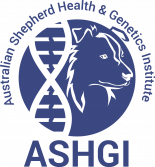Are muscle tremors in Aussies sign of a disease?
It would depend on the situation. If the dog is fatigued, it may simply be a sign of overworked muscles. If there are other signs of something wrong, like a suddenly abnormal gait, exercise intolerance, or a tendency to collapse there may be something else wrong. In a situation like that the dog should be taken to a vet for evaluation. (Try to take a video of what’s going on because it may not be happening by the time you get to the vet’s office.) However, some Aussies have muscle tremors alone. The tremors may be a sign of a largely benign condition called hypomyelinogenesis. Some owners report it only happens when the dog is excited or stressed but it can also happen when the dog is standing calmly. The muscles, usually in the hindquarters but sometimes in the forequarters, too, will quiver.
My dog is very intense, is this why he has tremors?
Possibly, if it only happens when she is closely focused on some object or activity.
Do muscle tremors mean my dog has epilepsy?
In most cases, no. A dog having a seizure would almost certainly be having other signs indicating that a seizure was in progress. With epilepsy, nerves in the brain fail to turn off the current when they should. The open switch causes a chain reaction, overloading one neuron after another. If only a small area of the brain is affected, you get a focal seizure, a minor event that might include muscle tremors. If it affects a large area you get major seizures that will cause far more that muscle tremors. Epileptic seizures are centered in the brain. The misfiring motor nerves that cause the leg tremors are localized and do not affect the brain. If a dog had epilepsy and and also had tremors when not seizing it would be coincidence.
What is hypomyelinogenesis?
Myelin is the “insulation” on nerves. In hypomyelinogenesis, this insulation failed to develop properly. The most frequent sign of the disease is muscle tremors though in some species there may be seizures. Clumsiness when walking and head tremors may be seen in young puppies but typically go away. In these cases the myelin development may only have been delayed and the tremoring ceases as the myelin develops. However, muscle tremors may persist in adult dogs. The seizures reported in some species are likely due to a lack of myelinization is in the brain. However, this doesn’t spear to be the case in dogs.
What causes hypomyelinogenesis?
Information on this disease in dogs is limited. Causes of the disease across species include infection, dietary imbalance, and heredity.
What does having hypomyelinogenesis mean for my dog?
If the muscle tremor frequently seen in Aussies is hypomyelinogenesis, the impact on the dog is very minor. The tremors come and go and do not appear to be associated with any of the other symptoms reported with this disease.
How common is hypomyelinogenesis?
If the typical Aussie muscle tremor is hypomyelinogenesis, very common.
Is hypomyelinogenesis hereditary?
It is in several breeds, none of them collie-type. In those breeds it is X-linked so it would be seen more frequently in males than females. There is no information indicating this is the case in Aussies, but it has been reported in related dogs so heredity is a possibility.
What does hypomyelinogenesis mean to my breeding program?
The effects of the muscle tremors, whether or not they are a form of hypomyelinogenesis, are so minor it isn’t cause to withhold a dog from breeding. However, it is unsightly and calling it a minor fault is justified. If you don’t like it, don’t breed dogs that have it to each other and avoid normal mates who have numerous affected family members.
